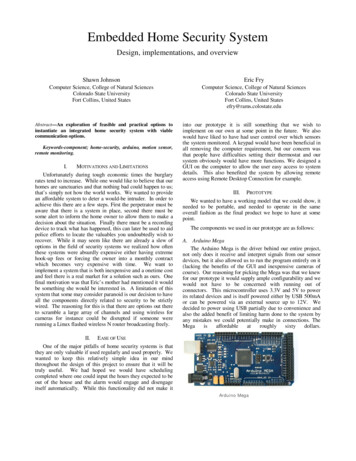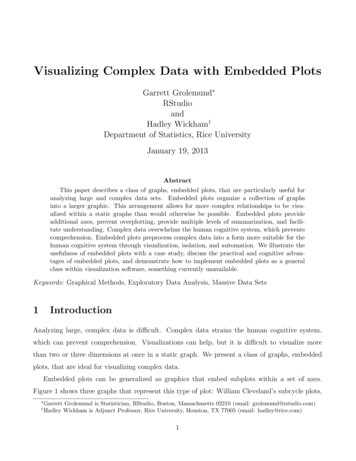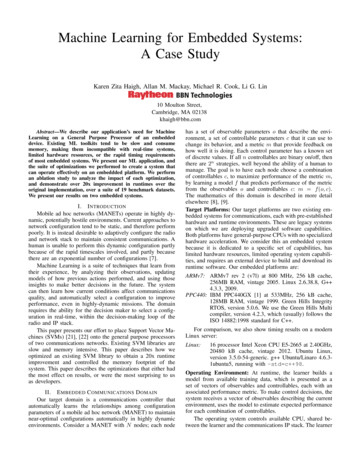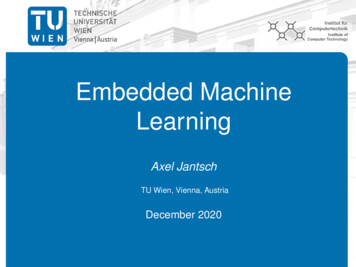
Transcription
10Embedded SQL After completing this chapter, you should be able to. work with programming language (PL) interfaces to anRDBMS, the basis for database application development,. develop (simple) programs that use Embedded SQL,Syntax of Embedded SQL, how to preprocess/compile Cprograms containing embedded SQL statements, usage ofhost variables, error handling, indicator variables, etc. explain the use of cursors (and why they are needed tointerface with a PL).
11Embedded SQLOverview1. Introduction and Overview2.Embedded SQL
12Introduction (1) SQL is a database language, but not a programminglanguage. Complex queries (and updates) may be expressed usingrather short SQL commands.Writing equivalent code in C would take significantly moretime. SQL, however, is not functionally complete.Not every computable function on the database states isexpressible in SQL. Otherwise, termination of queryevaluation could not be guaranteed.
13Introduction (2) SQL is used directly for ad-hoc queries or one-time updatesof the data. Repeating tasks have to be supported by applicationprograms written in some PL.Internally, these programs generate SQL commands which arethen shipped to the DBMS. Most database users do not know SQL or are even unawarethat they interact with a DBMS. Even if a user knows SQL, an application program might bemore effective than the plain SQL console.Think of visual representation of query results or sanitychecks during data entry.
14Introduction (3) Languages/tools widely used for database applicationprogramming:. SQL scripts,Like UNIX shell scripting language but interpreted bynon-interactive SQL console. C with Embedded SQL,. C with library procedure calls (ODBC),. Java with library procedure calls (JDBC),. Scripting languages (Perl/DBI, PHP (LAMP),Python/DB-API, . . . ),. Web interfaces (CGI, Java Servlets, . . . ).
15Introduction (4) Almost always, developers work with more than one language(e.g., C and SQL) to develop an application.This leads to several problems:. The interface is not smooth: type systems differ and theinfamous impedance mismatch problem occurs.Impedance mismatch: SQL is declarative and set-oriented.Most PLs are imperative and record- (tuple-) oriented. SQL commands are spread throughout the application codeand can never be optimized as a whole database workload. Query evaluation plans should be persistently kept inside theDBMS between program executions, but programs areexternal to the DBMS.
16Introduction (5) Note that these problems could be avoided with realdatabase programming languages, i.e., a tight integration ofDBMS and PL compiler and runtime environment.Proposed solutons:. Persistent programming languages (e.g., Napier88,Tycoon, Pascal/R [Pascal with type relation]),. stored procedures,Application code stored inside DBMS, DBMS kernel hasbuilt-in language interpreter or calls upon external interpreter. object-oriented DBMS,OODBMS stores methods (behaviour) along with data. deductive DBMS.DBMS acts as huge fact storage for a Prolog-style PL.
17Making Good Use of SQL Way too often, application programs use a relational DBMSonly to make records persistent, but perform all computationunder the control of the PL.Such programs typically retrieve single rows (records)one-by-one and perform joins and aggregations by themselves. Using more powerful SQL commands might. simplify the program, and. significantly improve the performance.There is a considerable overhead for executing an SQLstatement: send to DBMS server, compile command, sendresult back. The fewer SQL statements sent, the better.
18Example H1M1POINTS10812991057
19Embedded SQLOverview1.Introduction and Overview2. Embedded SQL
20Embedded SQL (1) Embdedded SQL inserts specially marked SQL statementsinto program source texts written in C, C , Cobol, andother PLs. Inside SQL statements, variables of the PL may be usedwhere SQL allows a constant term only (parameterizedqueries).Insert a row into table RESULTS:EXEC SQL INSERT INTO RESULTS(SID, CAT, ENO, POINTS)VALUES (:sid, :cat, :eno, :points);. Here, sid etc. are C variables and the above may beemdbedded into any C source text.
21Embedded SQL (2)Compilation/linkage of Embedded SQL programsC program with Embedded SQL (*.pc) DBMS-supplied precompilerPure C program with procedure calls (*.c)Standard C compiler (e.g., gcc) Object code (.o)DBMS libraryjjjjjjj(Dynamic) linkerjjjj(ld, ld.so) ujjjjExecutable program
22A Mini C Recap (1) The C programming language was designed by Dennis Ritchiearound 1972 at Bell Labs.Traditional first C program.#include stdio.h int main (void){printf ("Hello, world!\n");return 0;}/* \n newline */Execution starts at mandatory procedure main. Return value 0is a signal to the OS that the execution went OK (also seeexit()). Header file "stdio.h" contains declaration of libraryfunction printf used for output. Braces ({, }) enclose nestedstatement blocks.
23A Mini C Recap (2) In C, a variable declaration is written ashTypei hVariablei ;Declare integer variable sid:int sid; /* student ID */ There are integer types of different size, e.g., long and short.The type short (or short int) typically is 16 bits wide: 32768 . . . 32767. Type int corresponds to the word size ofthe machine (today: 32 bits). Type long is at least 32 bitswide. Integer types may be modified with the unsigned prefix,e.g., unsigned short has the range 0 . . . 65535.
24A Mini C Recap (3) The type char is used to represent characters (today,effectively an 8 bit value).The type unsigned char is guaranteed to provide the valuerange 0 . . . 255.Declaration of an array of characters a[0].a[19]:char a[20]; In C, strings are represented as such character arrays. A nullcharacter (’\0’) is used to mark the string end.String "xyz" is represented as a[0] ’x’, a[1] ’y’,a[2] ’z’, a[3] ’\0’.
25A Mini C Recap (4) Variable assignment:sid 101; Conditional statement:if (retcode 0)/* is equality */printf ("Ok!\n");elseprintf ("Error!"\n); C has no Boolean type but uses the type int instead torepresent truth values: 0 represents false, anything elseindicates true.
26A Mini C Recap (5) Print an integer (printf: print formatted):printf ("The current student ID is: %d\n", sid);First argument is a format string that determines number andtype of further arguments. Format specifiers like %d (print intin decimal notation) consume further elements in order. Read an integer (%d: in decimal notation):ok scanf ("%d", &sid);&sid denotes a pointer to variable sid. Since C knows call byvalue only, references are implemented in terms of pointers.Library function scanf returns the number of converted formatelements (here 1 if no problems occur). Trailing newlines arenot read.
27A Mini C Recap (6) Suppose that variable name is declared aschar name[21]; In C, variable assignment via does not work for strings(arrays), instead use the library function strncpy (declared inheader file "string.h"):strncpy (name, "Smith", 21);The C philosophy is that should correspond to a singlemachine instruction. In C, the programmer is responsible toavoid string/buffer overruns during copying. This is the sourceof nasty bugs and security holes. strncpy never copies morecharacters than specified in the last argument.
28A Mini C Recap (7) To read an entire line of characters (user input) from theterminal, usefgets (name, 21, stdin);name[(strlen (name) - 1] ’\0’;/* overwrite ’\n’ */The second argument of fgets specifies the maximum numberof characters read (minus 1). A trailing newline is stored and a’\0’ is placed to mark the string end. stdin denotes theterminal (if not redirected). Library function strlen does theobvious.
29Host Variables (1) If SQL is embedded in C, then C is the host language. Cvariables which are to be used in SQL statements are referredto as host variables. Note that SQL uses a type system which is quite differentfrom the C type system.For example, C has no type DATE and no C type corresponds toNUMERIC(30). In addition, C has no notion of null values. Even if there is a natural correspondence between an SQLtype and a C type, the value storage format might beconsiderable different.Think of endianness, for example.
30Host Variables (2) Oracle, for example, stores variable length strings (SQL typeVARCHAR(n)) as a pair hlength information, array ofcharactersi. C uses ’\0’-terminated char arrays. Oracle stores numbers with mantissa and exponent (scientificnotation) with the mantissa represented in BCD (4 bits/digit).C uses a binary representation. Type/storage format conversion has to take place wheneverdata values are passed to/from the DBMS. The precompiler can help quite a lot here, but some workremains for the programmer.
31Host Variables (3) The DBMS maintains a translation table between internaltypes and external types (host language types) and possibleconversions between these. In Embedded SQL, many conversion happen automatically,e.g., NUMERIC(p), p 10, into the C type int (32 bits).Also, NUMERIC(p,s) may be mapped to double, althoughprecision may be lost. For VARCHAR(n), however, the program either prepares C astruct that corresponds to the DBMS storage format orexplicitly states that a conversion to ’\0’-terminated Cstrings is to be done.
32Host Variables (4) The precompiler must be able to extract and understand thedeclaration of the host variables. Usually, the Embedded SQL precompiler does not fully“understand” the C syntax (with all its oddities).Correct C declaration syntax?unsigned short intunsigned int shortshort unsigned intshort int unsignedint unsigned shortint short unsigned Thus, variable declarations relevant to the precompiler mustbe enclosed in EXEC SQL BEGIN DECLARE SECTION and EXECSQL END DECLARE SECTION.
33Host Variables (5) The declaration section might look as follows:EXEC SQL BEGIN DECLARE SECTION;intsid;/* student ID */VARCHAR first[20];/* student first name */charlast[21];/* student last name */EXEC SQL VAR last IS STRING(20);EXEC SQL END DECLARE SECTION;. sid is a standard C integer variable, the DBMS willautomatically convert to and from NUMERIC(p). last is a standard C character array (string).The conversion to/from this format is explicitly requested(note: due to ’\0’-termination, max. string length is 20).
34Host Variables (6) VARCHAR first[20] is not a standard C data type. The precompiler translates this declaration intostruct { unsigned short len;unsigned char arr[20];} first;which is a C type whose memory layout exactly matchesthe DBMS-internal VARCHAR(20) representation. The conversion from a standard C char array s could bedone as follows:first.len MIN (strlen (s), 20);strncpy (first.arr, s, 20);
35Host Variables (7) The variables in the DECLARE SECTION may be global as wellas local. The types of these variables must be such that theprecompiler can interpret them.Especially, non-standard user-defined types (typedef) are notallowed here. In SQL statements, host variables are prefixed with a colon(:) and may thus have the same name as table columns.
36Error Checking (1) Similar coding guidelines apply whenever the programinteracts with the operating system or with the DBMS: afterevery interaction check for possible error conditions. One possibility to do this is to declare a special variablechar SQLSTATE[6]; As required by the SQL-92 standard, if this variable isdeclared, the DBMS stores a return code whenever an SQLstatement has been executed.SQLSTATE contains error class and subclass codes. Firsttwo characters "00" indicate “okay ” and, for example,"02" indicates “no more tuples to be returned”.
37Error Checking (2) An alternative is the SQL communication area sqlca (a Cstruct) which can be declared viaEXEC SQL INCLUDE SQLCA;. Component sqlca.sqlcode then contains the return code,for example, 0 for “okay ”, 1403: “no more tuples”. Component sqlca.sqlerrm.sqlerrmc contains the errormessage text, sqlca.sqlerrm.sqlerrml contains itslength:printf ("%.*s\n", sqlca.sqlerrm.sqlerrml,sqlca.sqlerrm.sqlerrmc);
38Error Checking (3) The precompiler supports the programmer in enforcing aconsistent error checking discipline:EXEC SQL WHENEVER SQLERROR GOTO hLabeli;orEXEC SQL WHENEVER SQLERROR DO hStmti;. The C statement hStmti typically is a C procedure call toan error handling routine (any C statement is allowed). Such WHENEVER SQLERROR declarations may be cancelled viaEXEC SQL WHENEVER SQLERROR CONTINUE;
39Example Database 1M1POINTS10812991057
40Example (1)/* program to enter a new exercise */#include stdio.h EXEC SQL INCLUDE SQLCA;/* SQL communication area */EXEC SQL BEGIN DECLARE SECTION;VARCHAR user[128];/* DB user name */VARCHAR pw[32];/* password */VARCHAR cat[1];inteno;intpoints;VARCHAR topic[42];EXEC SQL END DECLARE SECTION;.
41Example (2)./* called in case of (non-SQL) errors */void fail (const char msg[]){/* print error message */fprintf (stderr, "Error: %s\n", msg);/* close DB connection */EXEC SQL ROLLBACK WORK RELEASE;/* terminate */exit (1);}.
42Example (3).int main (void){char line[80];/* catch SQL errors */EXEC SQL WHENEVER SQLERROR GOTO error;/* log into DBMS */strncpy (user.arr, "grust", 128);user.len strlen (user.arr);strncpy (pw.arr, "******", 32);pw.len strlen (pw.arr);EXEC SQL CONNECT :user IDENTIFIED BY :pw;.
43Example (4)./* read CAT, ENO of new exercise */printf ("Enter data of new exercise:\n");printf ("Category (H,M,F) and
EXERCISES CAT ENO TOPIC MAXPT H 1 Rel.Alg. 10 H 2 SQL 10 M 1 SQL 14 RESULTS SID CAT ENO POINTS 101 H 1 10 101 H 2 8 101 M 1 12 102 H 1 9 102 H 2 9 102 M 1 10 103 H 1 5 103 M 1 7. Embedded SQL 19 Overview 1. Introduction and Overview 2. Embedded SQL. Embedded SQL (1) 20 Embdedded SQL inserts specially marked SQL statements into program source texts written in C,











